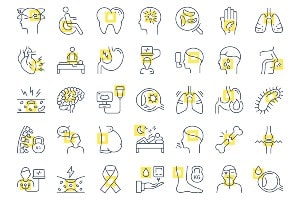About Intermittent Claudication (Claudication)

Learn about the disease, illness and/or condition Intermittent Claudication (Claudication) including: symptoms, causes, treatments, contraindications and conditions at ClusterMed.info.
Intermittent Claudication (Claudication)

| Intermittent Claudication (Claudication) |
|---|
Intermittent Claudication (Claudication) InformationCan claudication be prevented?Some of the risk factors for claudication are behaviors that can be modified such as:
How is claudication diagnosed?A physician will take a history and the diagnosis will be based on the patient's symptoms. Testing for claudication may include:
What are the risk factors for claudication and peripheral vascular disease?Risk factors for peripheral artery disease and claudication include:
What are the symptoms of claudication?Pain and cramping in the legs is the main symptom of claudication. Pain can be sharp or dull, aching or throbbing, or burning. The severity of the peripheral artery disease, the location of the plaque, and the activity of the muscles determine the severity of symptoms and location of pain. Calf pain is the most common location for leg cramps. This is because the atherosclerotic plaques often begin in the arteries farthest from the heart. If the blockage or plaque formation is farther up the leg, the pain from claudication may be felt in the thigh. If the blockage is in the aorta (the main artery from the heart to the legs) then symptoms may include pain in the buttocks or groin or erectile dysfunction. What can cause the artery narrowing that leads to claudication?Intermittent claudication can be due to temporary artery narrowing due to spasm of the artery (vasospasm), permanent artery narrowing due to atherosclerosis, or from the complete blockage of an artery of the leg. What causes claudication?Several medical problems can cause claudication, but the most common is peripheral artery disease. Peripheral artery disease (PAD) is caused by atherosclerosis, which is a hardening of the arteries from accumulation of cholesterol plaques that form on the inner lining of the arteries. This is especially common at branching points of the arteries in the legs. Blockage of the arteries from these plaques causes low blood flow to the muscles in the legs. When walking or exercising the muscles in the legs require more blood flow to increase oxygen to the cells. Atherosclerotic plaques cause decreased blood flow and decreased oxygen. The muscles of the legs can ache and burn as a result of inadequate oxygen. This is felt as cramping in the legs. What is claudication?Claudication is pain and/or cramping in the lower leg due to inadequate blood flow to the muscles. The pain usually causes the person to limp. The word "claudication" comes from the Latin "claudicare" meaning to limp. Claudication typically is felt while walking, and subsides with rest. It is commonly referred to as "intermittent" claudication because it comes and goes with exertion and rest. In severe claudication, the pain is also felt at rest. What is the prognosis and treatment for patients with intermittent claudication?The prognosis of claudication is generally favorable with treatment. Without treatment, 26% of patients worsen over time. Over 5 years, 4% to 8% will progress to require a revascularization procedure. The underlying cause of claudication, peripheral vascular disease, does put patients at risk for other atherosclerotic diseases. A finding of claudication or peripheral artery disease should be considered a warning sign of other potential atherosclerotic blockages in the body. What is the treatment for claudication?There are two main ways to treat claudication: medication and a surgical treatment, called revascularization. Medication therapies are often used initially as they are non-invasive. The two most commonly used medications include:
Who typically is affected by claudication?Intermittent claudication is more common in men than in women. The condition affects 1% to 2% of the population under 60 years of age, increasing in incidence with age, to affect over 18% of persons over 70 years of age, according to the American Academy of Family Physicians. Why does claudication come and go?The usually intermittent nature of the pain of claudication is due to a temporary inadequate supply of oxygen to the muscles of the leg. The poor oxygen supply is a result of narrowing of the arteries that supply the leg with blood. This limits the supply of oxygen to the leg muscles and is especially noticeable when the oxygen requirement of these muscles rises with exercise or walking. Claudication that comes and goes is often referred to as intermittent claudication. |
More Diseases
A | B | C | D | E | F | G | H | I | J | K | L | M | N | O | P | Q | R | S | T | U | V | W | X | Y | Z
Diseases & Illnesses Definitions Of The Day
- Eating, Emotional (Emotional Eating) ‐ Emotional eating facts, How do health care providers diagnose emotional eating? …
- OTC Drugs for Constipation (Laxatives For Constipation) ‐ Are laxatives safe to take during pregnancy or while breastfeeding? …
- Hyopgonadism, Primary (Low Testosterone (Low T)) ‐ How do you know if you have low testosterone (Low-T)?, Should I take testosterone? …
- Poisoning, Ciguatera (Ciguatera Poisoning) ‐ What are the symptoms of ciguatera poisoning?, What is ciguatera poisoning? …
- Head and Neck Cancer ‐ Head and neck cancer facts*, How are head and neck cancers diagnosed? …
- XXY Males (Klinefelter Syndrome) ‐ Klinefelter syndrome facts*, Language development, Physical development …
- Devic's Syndrome ‐ How is neuromyelitis optica diagnosed?, Neuromyelitis optica facts* …
- Myocarditis ‐ How is myocarditis diagnosed?, What are symptoms of myocarditis? …
- Cancer of the Testis (Testicular Cancer) ‐ After testicular cancer has been diagnosed, tests are done to find out if cancer cells have spread within the testicles or to other parts of the body. …
- Chronic Rhinitis ‐ Chronic rhinitis and post-nasal drip definition and facts, Does salt water or nasal irrigation have any role in the treatment of rhinitis and post-nasal drip? …